Euro PM2012: New Powder Metallurgy applications for the nuclear energy sector via Hot Isostatic Pressing
PM/HIP Borated Steels used for absorbing neutrons in spent nuclear fuels
Borated stainless steels have been used in racks in wet storage tanks holding spent fuel from nuclear reactors for a number of years, with the boron in the stainless steels absorbing the neutrons from the spent fuel over a long period of time.
Louis Lherbier and David Novotnak of Carpenter Powder Products, Bridgeville, PA, USA, presented a report at Euro PM2012 which described the problems of processing stainless steels with high boron content (up to 2.25% B) via the conventional cast and wrought route, and how the PM/HIP route was able to achieve superior mechanical properties, plus a fine uniform distribution of borides even at levels exceeding 2% B.
It is projected that by 2030 there will be an extra 502 nuclear reactors in addition to the 430 reactors already operating commercially today. A quarter to one-third of the spent nuclear fuel rods from these reactors must be removed from a reactor every 12 to 24 months and placed in either a temporary on-site dry storage facility or, as in most cases, on racks in wet storage pools (Fig.1).

Fig. 1 Applications for borated stainless steels in wet storage racks for spent nuclear fuel (left) and the inner vacuum wall of the ITER fusion reactor (right). (From paper by L.W. Lherbier and D.J. Novotnak: ‘Advantages of Manufacturing Neutron-Absorbing Borated Stainless steels using PM/HIP Technology’, presented at Euro PM2012, Basel, September 16-19, and published in the Conference Proceedings by EPMA, Shrewsbury, UK)
The spent fuel rods will continue to emit radioactive neutrons and these must be captured in the storage pools using composites or stainless steels with high levels of boron which absorbs the neutrons for many years. The authors stated that the neutrons are actually absorbed by the B10 isotope which comprises approximately 19% of the boron total in natural boron.
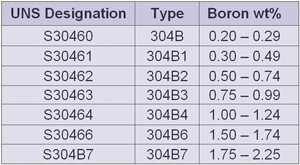
Table 1 Boron ranges for ASTM A887 (From paper by
L.W. Lherbier and D.J. Novotnak: ‘Advantages of
Manufacturing Neutron-Absorbing Borated Stainless
steels using PM/HIP Technology’, presented at Euro
PM2012, and published in the Conference
Proceedings by EPMA, Shrewsbury, UK)
However, as the boron content in borated stainless steels increases to as high as 2.25%, so properties such as ductility, toughness and fabricability of the stainless steel decreases. This makes it difficult, or impossible, to fabricate by conventional processing such as hot or cold rolling to final thicknesses of the sheet and plate products used in rack material. Even at levels of up to 2% of boron, existing boron containing stainless steels covered by specification ASTM A 887-89 (Table 1) can cause manufacturing difficulties such as poor mill processing characteristics and low product yields.

Fig. 2 As-HIPed round and slab preforms from borated stainless steels. (From paper by L.W. Lherbier and D.J. Novotnak: ‘Advantages of Manufacturing Neutron-Absorbing Borated Stainless steels using PM/HIP Technology’, presented at EuroPM2012, Basel, September 16-19, and published in the Conference Proceedings by EPMA, Shrewsbury, UK)
The research presented by the authors therefore focused on producing the borated stainless steels 304B4, 304B6, and 304B7 by the PM/HIP route. The prealloyed powders were produced by gas atomization and, following screening, the powders were loaded into metal containers, degassed and sealed, then HIPed to fully dense preforms. Preform shapes can be round or slab forms depending on the final application (Fig.2)
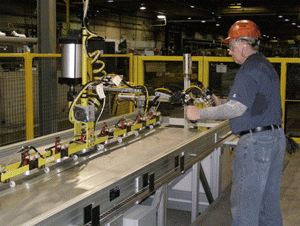
Fig. 3 Testing of boron uniformity in the final borated
stainless steel product (From paper by
L.W. Lherbier and D.J. Novotnak: ‘Advantages of
Manufacturing Neutron-Absorbing Borated Stainless
steels using PM/HIP Technology’, presented at Euro
PM2012, and published in the Conference
Proceedings by EPMA, Shrewsbury, UK)
Subsequent processing included hot rolling and cold rolling to final thicknesses of 1.5mm to 40mm by varying widths. Continuously rolled thin strip requires both hot and cold rolling to reach finish gauge. The authors stated that PM/HIP starting preforms allow this material to be continuously cold rolled to thin-gauges without severe edge cracking, particularly at high boron levels. Thin gauge cold rolled strip is flattened and cut to length as required by the application.
Processed material was evaluated for microstructure, mechanical properties and boride uniformity in the product through the use of a JEN 3 gauge. The JEN 3 equipment was designed and built by CEA, France, to assure that finished product has a uniform distribution of borides throughout the material (Fig.3).
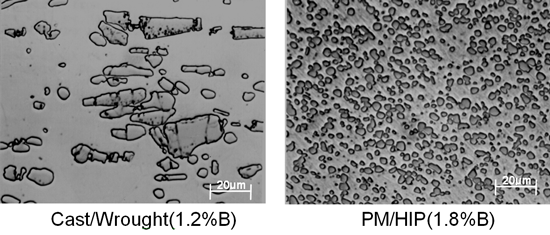
Fig. 4 Comparative structures of cast + wrought (left) and PM/HIP borated stainless steels. (From paper by L.W. Lherbier and D.J. Novotnak: ‘Advantages of Manufacturing Neutron-Absorbing Borated Stainless steels using PM/HIP Technology’, presented at EuroPM2012, Basel, September 16-19, and published in the Conference Proceedings by EPMA, Shrewsbury, UK)
The uniform distribution of boron in the microstructure (Fig.4) allows the hot and cold working of this material with minimal or no edge cracking and high product yields. The PM/HIP borated stainless steels also showed superior mechanical properties in respect to strength, ductility and toughness, which the authors state should give rack manufacturers more leeway in designing and constructing their storage containers.
PM/HIP materials close to ASME code approval
In a separate presentation at Euro PM2012, Louis Lherbier and David Novotnak of Carpenter Powder Products, Bridgeville, PA, USA, together with co-author David Gandy of the Electric Power Research Institute (EPRI), Charlotte, North Carolina, USA, gave an update on the status of ASME Code Approval for PM/HIP 316L stainless steel for nuclear applications, and also Grade 91 alloy for fossil fuel applications.
The authors stated that a variety of PM/HIP components are already used in flanges, fittings and valves for high temperature applications using ASTM specifications. These include ASTM A988A for PM/HIP martensitic, austenitic, age hardening and austenitic-ferritic stainless steels and ASTM A989A for alloy steels. However, the ASME Boiler and Pressure Vessel Codes currently do not allow the use of PM/HIP near net shape produced components.
To overcome this obstacle, the EPRI initiated a programme teaming component manufacturers and valve customers to prepare a proposed ASME Code Case request to approve the use of PM/HIP valve components in nuclear and fossil fuel applications.

Table 2 Chemical analyses (wt%) of the two materials seeking ASME Code approval. (From paper by L.W. Lherbier, D.J. Novotnak and D.W. Gandy: ‘Status of ASME Code Approval for PM/HIP Near Net Shapes’ presented at Euro PM2012, Basel, September 16-19, and published in the Conference Proceedings by EPMA, Shrewsbury, UK)
The compositions of the two alloys studied by EPRI are shown in Table 2. The PM/HIP 316L stainless steel valve produced was aimed at a nuclear application. The grade 91 martensitic stainless steel valve was aimed at fossil fuel applications. The near net shape PM/HIP valves produced from each alloy have, or are undergoing, a complete metallurgical mechanical property evaluation with most of the information in this presentation based on results obtained on the 316Lstainless steel alloy which has reached completion. The authors stated that testing and evaluation of the Grade 91 alloy is still progressing and scheduled for completion in late 2012.
Each of the valve bodies produced were sectioned and evaluated for microstructural uniformity, grain size and cleanliness. The valves were also ultrasonically inspected to evaluate both the detection and sizing of potential defects. Mechanical properties were determined by tensile tests at room and elevated temperature as required. Data on crack growth rate and stress allowables as required by the ASME Code have been obtained on PM/HIP 316L and is in progress for Grade 91.
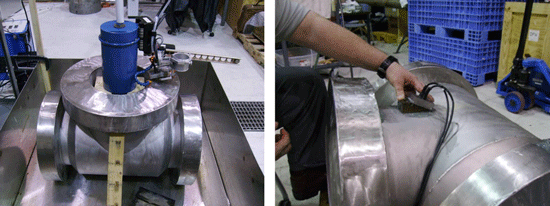
Fig. 5 Ultrasonic inspection of a large PM/HIP 316L stainless steel valve. (From paper by L.W. Lherbier, D.J. Novotnak and D.W. Gandy: ‘Status of ASME Code Approval for PM/HIP Near Net Shapes’ presented at Euro PM2012, Basel, September 16-19, and published in the Conference Proceedings by EPMA, Shrewsbury, UK)
In the case of the 316L PM/HIP valve a variety of corrosion tests have been conducted and are also planned for Grade 91. Tests include stress corrosion, transgranular and intergranular, crevice corrosion, the IGA oxalic test and resistance to the ferric chloride pitting test.
As illustrated in Fig. 5, the valves were ultrasonically inspected. Both manual and automated inspection showed all material to be highly inspectable and free of defects. No non-metallic or porosity indications were observed and no special preparation of the valve surface was required.
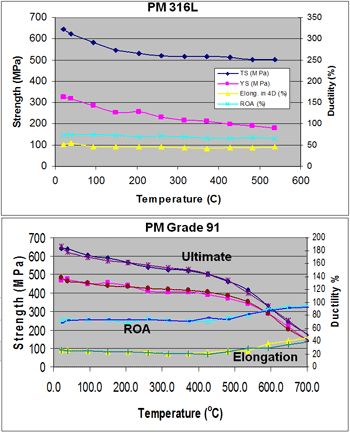
Fig. 6 Elevated temperature mechanical properties
for PM/HIP 316L and PM Grade 91. (From paper by
L.W. Lherbier and D.J. Novotnak: ‘Advantages of
Manufacturing Neutron-Absorbing Borated Stainless
steels using PM/HIP Technology’, presented at Euro
PM2012, and published in the Conference
Proceedings by EPMA, Shrewsbury, UK)
In contrast a cast valve cannot be ultrasonically inspected and while a forged valve may be ultrasonically inspected, variable grain size and directional grain flow can cause problems. The authors stated that the PM/HIP material met or exceeded results obtained on a standard 316L stainless steel in all cases.
Fig. 6 illustrates the tensile properties of 316L and Grade 91 over a range of temperatures. PM/HIP material is as good as, or better than, standard 316L over the entire temperature range.
The authors stated that for alloy 316L the data package along with design stress intensity and maximum allowable stress values has been submitted to ASME for approval. All committee issues have been resolved and final ASME code approval for PM/HIP components was obtained in May 2012.
Data collection on the Grade 91 martensitic alloy is said to be progressing and all mechanical property and metallographic evaluation have been completed on this alloy. A compilation of data for ASME Code case approval must await a rigorous test matrix for creep and stress rupture testing for times up to 10,000 hours. The testing reached 8,000 hours at the time of writing, and all results look good. At the current rate of progress ASME Code approval is expected by the end of 2012.
News | Articles | Market reviews | Search directory | Subscribe to e-newsletter





